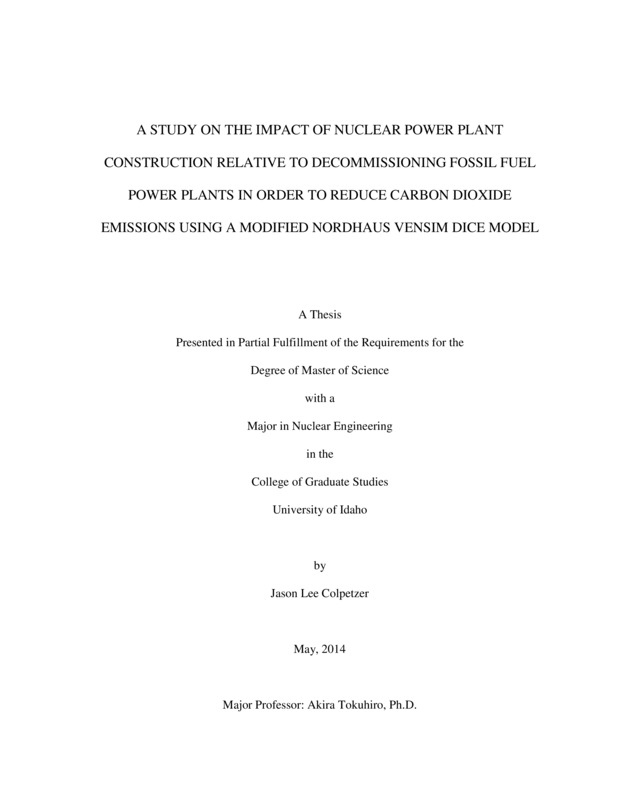A Study on the Impact of Nuclear Power Plant Construction Relative to Decommissioning Fossil Fuel Power Plants in Order to Reduce Carbon Dioxide Emissions Using a Modified Nordhaus Vensim DICE Model
Colpetzer, Jason Lee. (2014). A Study on the Impact of Nuclear Power Plant Construction Relative to Decommissioning Fossil Fuel Power Plants in Order to Reduce Carbon Dioxide Emissions Using a Modified Nordhaus Vensim DICE Model. Theses and Dissertations Collection, University of Idaho Library Digital Collections. https://www.lib.uidaho.edu/digital/etd/items/colpetzer_idaho_0089m_10213.html
- Title:
- A Study on the Impact of Nuclear Power Plant Construction Relative to Decommissioning Fossil Fuel Power Plants in Order to Reduce Carbon Dioxide Emissions Using a Modified Nordhaus Vensim DICE Model
- Author:
- Colpetzer, Jason Lee
- Date:
- 2014
- Keywords:
- Climate Change DICE Fossil Fuel Power Plants Nuclear Power Nuclear Power Plants
- Program:
- Mechanical Engineering
- Subject Category:
- Nuclear engineering; Climate change
- Abstract:
-
The current levels of CO2 emissions and high levels accumulating in the atmosphere have climate scientists concerned. The Dynamic Integrated Climate Economy Model or "DICE" for short is a highly developed model that has been used to simulate climate change and evaluate factors addressing global warming. The model was developed by Yale's Nordhaus along with collaborators and the compilation of numerous scientific publications. The purpose of this study is to recreate DICE using Vensim and modify it to evaluate the use of nuclear power plants (NPPs) as a means to counter global temperature increases in the atmosphere and oceans and the associated cost of damages. The amount of greenhouse gas emissions from a NPP are about 6% per Megawatt as that from a Fossil Fuel Power Plant (FFPP). Based on this, a model was developed to simulate construction of NPPs with subsequent decommissioning of FFPPs with an equivalent power output. The results produced through multiple simulation runs utilizing variable NPP construction rates show that some minor benefit is achievable if all of the more than 10,000 FFPPs currently in operation in the U.S. are replaced with NPPs. The results show that a reduction in CO2 emissions of 2.48% will occur if all of the FFPPs are decommissioned. At a minimum rate of 50 NPPs constructed per year, the largest reduction in CO2 in the atmosphere, 1.94% or 44.5 billion tons of carbon, is possible. This results in a reduction in global warming of 0.068°C or 1.31%. The results also show that this reduction in global warming will be equivalent to a reduction of 8.2% or $148 B in anticipated annual spending as a result of climate change damages. Further results indicate that using NPPs to address climate change will provide a small benefit; ultimately, it will not be enough to reduce CO2 emissions or atmospheric CO2 to control global warming. The amount of CO2 in the atmosphere is predicted to be 1055 parts per million (ppm) even in the best case scenario, which is well above the current limit of 350 ppm proposed by Hansen et. al.
- Description:
- masters, M.S., Mechanical Engineering -- University of Idaho - College of Graduate Studies, 2014
- Major Professor:
- Tokuhiro, Akira
- Committee:
- Solan, David; Utgikar, Vivik; Phongikaroon, Supathorn
- Defense Date:
- 2014
- Identifier:
- Colpetzer_idaho_0089M_10213
- Type:
- Text
- Format Original:
- Format:
- application/pdf
- Rights:
- In Copyright - Educational Use Permitted. For more information, please contact University of Idaho Library Special Collections and Archives Department at libspec@uidaho.edu.
- Standardized Rights:
- http://rightsstatements.org/vocab/InC-EDU/1.0/

